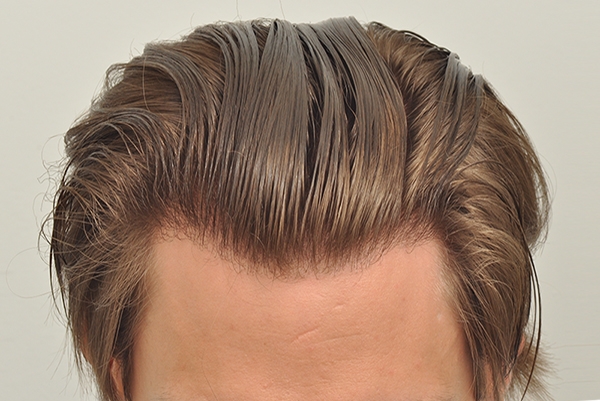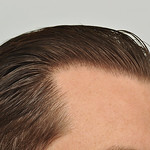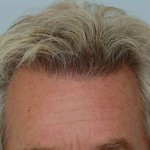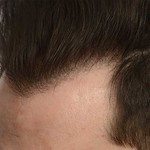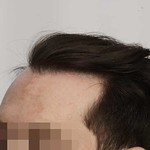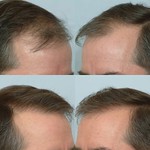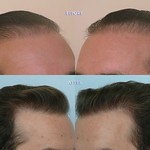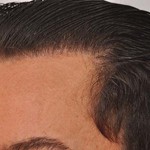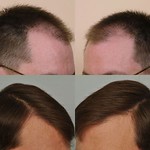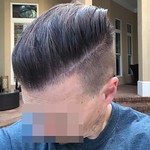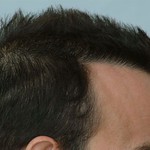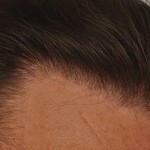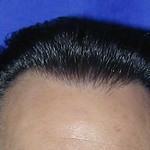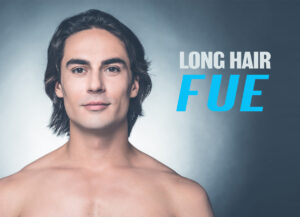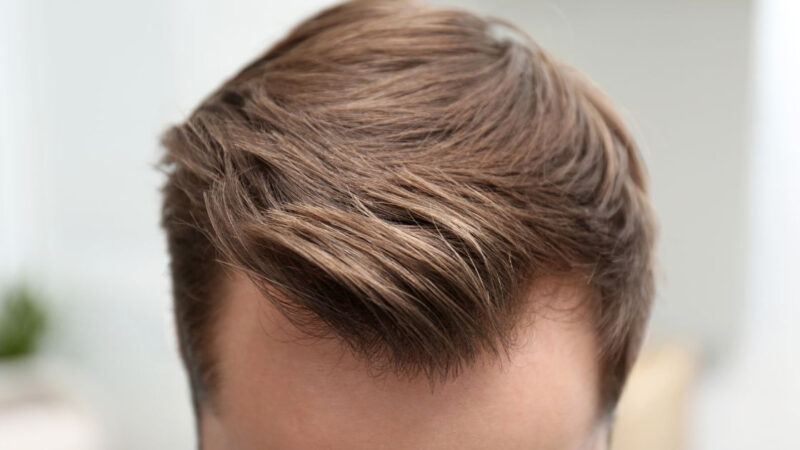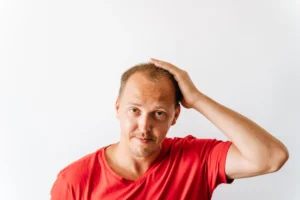Hairline is the first aspect people notice regardless if a transplant or not. Primarily a matter of the temporal point, receding hairlines create a corner effect that slowly traverses towards the head’s top. It is always a sign of pattern baldness and almost always affects males; female pattern baldness is typically diffuse and the hairline disperses rather than selectively loses hair.
The psychological imprint of a receding hairline can be tremendous. Hair loss to the back or top of the head is not instantly noticeable in front of the mirror, after all. Common wisdom, though not reality, is the older the person the greater the corner of their hairline. This is not always the case. People as young as their late teens and early twenties can put up with this type of pattern baldness too. Regardless of confidence or belief, the truth is scientifically established; those who appear more youthful enjoy greater social preference and confidence. Maintaining such can be critical for one’s job or sense of social acceptance. Logically, this cosmetic facet should also be of major concern for patients.
Most hair transplantation involves hairline lowering surgery. Achieving realistic density is important but a convincing result demands an understanding of how transplants effect and establish the hairline. Mostly considered a sign of age, the surgeon’s primary focus should be readjusting the hairline for a credible though flattering result. Simple in theory, follow-through requires education, training, and a deft hand. Many, if not most, patients need reparative surgery if they have an off hairline. The reason is simple; placing follicles is demanding and requires experience. This article will focus on everything to do with hairlines. Proper appearance and practice matter. Selection of the hair transplant surgeon is also vital, as is personally registering the quality of their work.
WHAT CONSTITUTES A NATURAL HAIRLINE?
Hair transplant hairline design is an intricate process that differentiates based on the technique. However, there are some common facets. A world-renowned hair restoration surgeon with a particular status for convincing hairlines, Dr. Cole has voluminous insight as to what constitutes an ideal hairline. “To achieve the appropriate hairline,” he begins, “one must choose the appropriate size graft and create the appropriate angle so that we get a very natural result.”
Dr. John P. Cole spoke about hair transplant hairlines and hairline repair at the FUE Hair Transplant Meetings:
WHY ARE HAIRLINES SO IMPORTANT?
The transplant graft sizes depend on the technique and surgeon, as detailed in the below section. Ditto for the angle of placement. Graft size should be small enough to create the fine appearance of a naturally occurring hairline. This was not always the case but, with the advent of modern techniques, patients should at least expect fine grafts at the front of the hairline even if they receive larger grafts towards the top of the head. Angle, meanwhile, is imperative for natural appearing growth. “A failure to follow these basic tenets of building a hairline will result in an unnatural appearing ‘pluggy’ hairline,” Dr. Cole cautions. “Many years ago I discovered that the way to create a natural hairline was to basically follow God’s rules, and God’s rules are that the hairline will start with single hair grafts, the hairline will then be followed with some two hair grafts, and only after you well into the hairline you’ll have grafts containing three hairs, and nothing with four hairs should be anywhere close to the hairline.”
Unfortunately, this is not always the case. “I see way too many hairlines today that start off with two, three, four hair grafts that are angled improperly on the hairline,” Dr. Cole warns. There are other risks too for hairline lowering surgery and hair transplant hairline design. Among the risks he mentions are “hairlines that are too low, hairlines that are not artistic, hairlines that disfigured the patient and require very expensive and time-consuming surgery.
Hairlines are so integral that they play a significant role in selecting a surgeon. A below section details how training, experience, and proven capability are all essential when picking a surgeon. The patient’s discretion is important, however. As Dr. Cole says, “The best thing you can do is recognize that the hairline is what separates the men from the boys; this is how you choose your surgeon.” The overall quality of coverage matters but particular attention must go into the hairlines. “Look at the hairlines,” he says, “because anyone can create coverage, doesn’t mean I will create perfect coverage but anyone can create coverage but only the best doctors can create a fantastic and natural hairline.”
The hairline will always depend on each patient’s specifics. Some will appear fine with a low, flat hairline, but only if hair loss is slight and their family has a history of said hairlines. Such a hairline can appear absolutely unnatural if the patient is older or otherwise would require an unsustainable amount of donor grafts. Keep in mind that the hairline established remains though thinning will slowly continue. For this reason, it is imperative that hairlines are designed to both appear believable and able to maintain in the future. We detail the latter in the section “Hairlines from Transplants and Longevity.”
HAIR TRANSPLANT TECHNIQUES AND HAIRLINE
Hair transplant technique is also crucial for a convincing hairline. Only recently has Follicular Unit Extraction, or FUE, become the most plentiful option within hair transplant surgery. The most recent variant available, it has several advantages over Follicular Unit Transplant, or FUT. The difference between the two can seem simple, starting with hair transplant cost, but the difference in results is profound.
There is obviously a reason why FUT is on the decline. This mentioned different versions of FUE each have their strengths. The unfortunate truth is that some are less effective than others even if they offer greater convenience to the surgeon.
| Advantages of FUE | Advantages of FUT |
|---|---|
| Much smaller graft sizes | More affordable |
| More convincing result | Always completed in a single session |
| Fast recovery time | A greater amount of expert surgeons |
| Greater control in graft placement | Applicable to a greater amount of patients |
| Good longevity |
THR BENEFITS OF FUE HAIR TRANSPLANT
Most patients are selecting FUE for its obvious benefits. In fact, many clinics are offering it to remain competitive within the industry. This does not mean, though, that all FUE transplants or FUE hairlines are of comparable quality. We explain why in the section “Selecting a Capable Hair Surgeon.” That mentioned, FUT should mostly be avoided nowadays. Many surgeons still primarily offering FUT will disagree, of course, but their incentive is largely income. They will typically claim FUE is inconsistent or otherwise inferior to FUT. Comparing the disadvantages side-by-side though, leads to a different story.
| Disadvantages of FUE | Disadvantages of FUT |
|---|---|
| Procedures take a greater amount of time | Greater chance of a pluggy, doll-like appearance towards the hairline |
| Requires intensive training and experience | Less longevity; the appearance of plugs surfaces as the transplant ages |
| Costlier, though with greater prevalence expense is declining | Far greater scarring that is both unpredictable and noticeable without correction |
| Inconsistent quality due to untrained and inexperienced surgeons offering the procedure | Longer recovery time more prone to complications |
| Manual FUE | Mechanical FUE | Automatic FUE | Robotic FUE |
|---|---|---|---|
| The surgeon individually extracts and places grafts | Surgeon uses a mechanical instrument to extract follicles and then places them manually | Surgeon or assistant places extracts and places follicles through an automatic device | An advanced instrument extracts follicles which are then placed manually |
| Greater control of extraction and placement of follicles for the hairline | Same control of extraction and placement as manual FUE Scarring | Requires less expertise but also has a greater transection rate | Currently applies only towards select patients |
| Least chance of scarring if done correctly | Scarring depends on the instrument and the surgeon’s familiarity with it | Greater chance of scarring | Higher chance of transection and scarring than manual and mechanical FUE |
ADVANCED FUE (CIT) TECHNIQUE
Besides different types of FUE there are also select subvariants. These differ based on the innovator but the prime marker of validity is practicing surgeons’ application and success. Cole Isolation Technique (CIT®), Dr. Cole’s unique versioning of FUE, is among these options. Taught worldwide and utilizing select utensils of his own invention, CIT® in fact most FUE does not offer.
-
- Minimally invasive, decreasing the chance of scarring
-
- Donor follicle renewal with the application of ACell
-
- Better control of placement and angle of grafts
-
- Greater efficiency of follicular extraction when using select instruments
Such strengths truly make this version a cut above the rest. Patients not only enjoy superior results, but future maintenance also is more effective. The regeneration of follicles is a huge advantage. With it, surgeons can extract the same follicles to encourage locational density later on.
HAIRLINES FROM TRANSPLANTS AND LONGEVITY
Regardless if the hair transplant is from FUE or FUT, aging will happen. This is not to say the transplanted hairs will shed. Instead, they will remain even as surrounding hair continues to thin. FUT transplants become particularly obvious, as the plugs create a doll-like appearance at the front of the scalp. FUE hair transplants, meanwhile, will appear sparser over time.
FUT requires correction. Surgeons must literally extract the grafts, separate them, and then place them back with additional transplants if they are available. Such reparative surgery can be quite costly but, for many patients with this older type of technique, it is necessary.
FUE, meanwhile, only requires maintenance. Surgeons must extract additional donor grafts and place them in thinning sections. This, first and foremost, requires having enough donor follicles. Said availability is both dependents on the patient’s earlier procedures and current state of balding. Selecting a decent surgeon the first time around, therefore, is essential. In the worst-case scenario, a surgeon will extract the transplants and then re-heighten and re-contour the hairline. Some may feel the hair transplant hairline too high but the cosmetic improvement is typically better than the original.
HAIR RETENTION AND OUTPATIENT/TAKE-HOME TREATMENTS
The only way to prevent thinning and balding around the recipient area is through treatments. Take-home and outpatient options are both available. Effectiveness ranges. The medicine improves while outpatient treatments are largely dependent on the clinic’s quality. Both are detailed below.
TAKE-HOME TREATMENTS
Finasteride, long prescribed orally, has fallen out of favor because of side effects. The vast majority of users do not suffer these side effects but enough do that doctors are no longer prescribing it. Instead, topical shampoos are being prescribed that research indicates lack these symptoms while providing even greater hair growth and retention. Oftentimes topical finasteride is combined with minoxidil, which encourages hair retention in most patients. One other complimentary topical treatment is methyl vanillate. This ingredient is one of the few, if only, that promotes WNT activity to prevent hair loss causing androgens.
Additionally, a number of all-natural substances help promote hair retention. While not typically considered as effective as finasteride or minoxidil they are still scientifically proven to keep hair healthy and growing. They include argan oil, rosemary, saw palmetto, and zinc. Regularly using shampoos with these ingredients may not completely stop hair loss but they do help with delaying it.
OUTPATIENT TREATMENTS
Clinics offer many treatments that can help encourage growth, thickness, and retention. The longest-standing is platelet-rich plasma (PRP), a treatment derived from the patient’s blood. Its effectiveness depends on its production and this varies by the clinic or local facility. An innovator in the field of hair growth treatments as well, Dr. Cole has personally developed a version of PRP that uses sonication rather than just centrifugation. It has five times the amount of growth factors, creating a profound increase in hair growth and health. For instance, administering it in conjunction with a hair transplant leads to growth in less than half a year rather. This is far better than with PRP, which encourages activation after half a year, or without any treatment, which causes activation within a year. ACell, an extracellular matrix typically used for wound recovery, prolongs the effect of these treatments significantly.
Further, new options are in development. Stem cell treatments are showing major potential, with patients for the first time enjoying significant follicular activation. Somewhat parallel to PRP, such treatments involve small biopsies, separation of follicular stem cell bearing tissue, centrifugation, and then the injection.
SELECTING A CAPABLE HAIR SURGEON
Finally, patients must exercise discretion when selecting their hair transplant specialist. As Dr. Cole explains in the section “What Constitutes a Believable Hairline?” a surgeon’s skill is showcased in the hairline’s creation. Hairline lowering surgery, a misnomer as the hairline is filled, is the ultimate marker of accomplishment within the field. It requires talent, skill, and training. Filling the top of the head is far simpler, with nearly all surgeons being able to accomplish such.
Impressive before and after photos and good references are an important element for selecting a surgeon. However, they are not the be-all, end-all of such. Photos can be altered, for instance, and sometimes references are profit-motivated or outright fake.
What other aspects should a patient consider when selecting a surgeon? Well, first and foremost medical background and training are essential. Look into where the surgeon was educated, where they trained, and who has endorsed them. Pioneers such as Dr. Cole helped establish FUE but most surgeons today can access regimented, if not wholly standardized, training that boosts their skill and primes them for patients. Experience counts for a lot, though. The best choice often has performed FUE on thousands of patients. Dr. Cole himself has performed on over 20,000 patients, for instance.
Besides experience and training, patients should look at industry activity and endorsements/awards. There are different organizations, some with better regard than others. Presence in the ISHRS is a good sign while participation with ABHRS shows concern for patient advocacy. Industry associations have leadership roles, training roles, and other nuances for a surgeon to make their mark. While not the only sign of an accomplished hair transplant surgeon, most become active to remain current in the industry as well as find recognition.
HAIRLINE: A CRUCIAL ELEMENT OF ANY WORTHWHILE HAIR TRANSPLANT
Thanks for reading this thorough primer on hairlines! The most intricate and challenging element for transplant surgeons, it is also among the most important aspects. That is not to say deftness at extraction also matters. Scarring and overharvesting remain two very important issues that require attention. However, a surgeon known for minimal scarring and responsible harvesting is more likely to also create a realistic and natural hairline.


